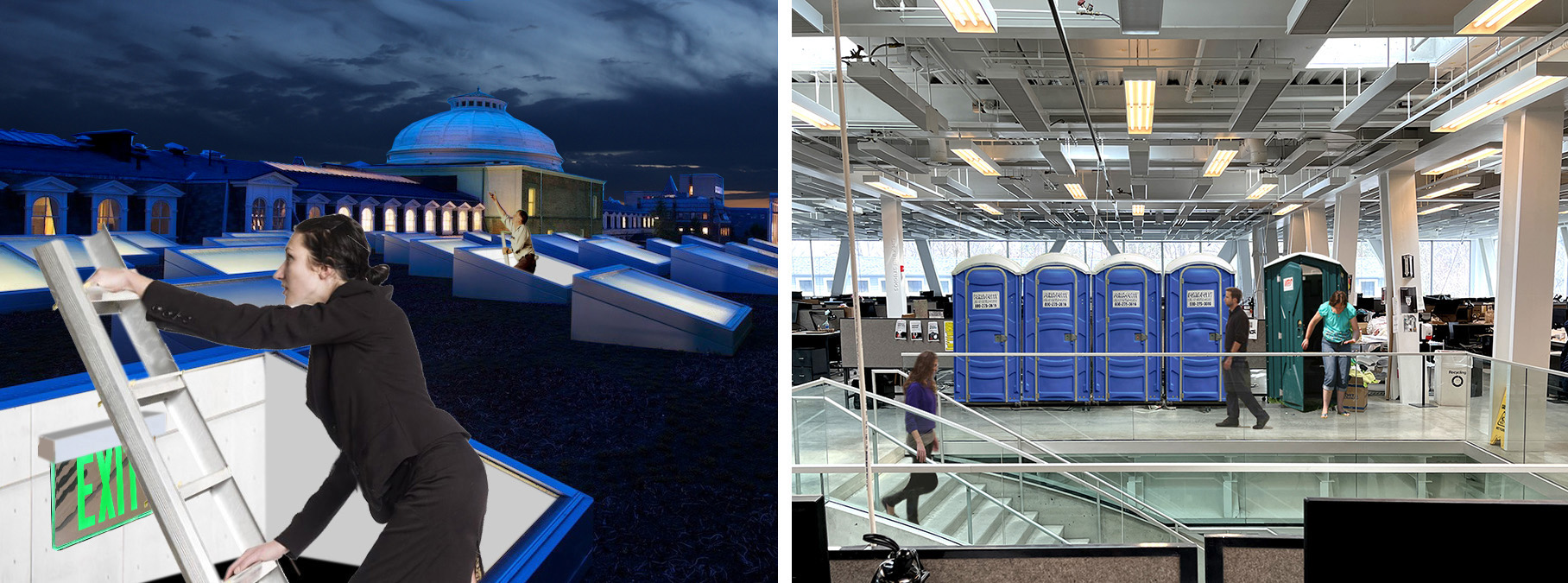
When the 14th International Architecture Exhibition at the Venice Biennale, provocatively titled Fundamentals, opened in June, 2014, it was bound to produce controversy. True to form, its director, Dutch architect Rem Koolhaas, a master at harnessing the drama of the contrary, promised a Biennale quite different from those that had come before. Under his gaze, rather than spotlight the specific works of contemporary architects, his Biennale focused on larger historical dynamics, going back in time and, literally, back to the basics. The operational theme, which Koolhaas called Elements of Architecture, covered basic, even mundane building parts like stairs and, of course, toilets. When asked by Cornell College of Architecture, Art and Planning (AAP) Dean Kent Kleinman to help with a temporary renovation of Milstein Hall—Koolhaas's signature building for AAP—he immediately agreed, seeing the project as a rare opportunity to test the conceptual framework he had proposed for Venice in a "real-life" situation. "Because Rand Hall was parasitically used as a dumping ground for many of the nasty things—like mechanical rooms, toilets, and egress stairs—that would otherwise have diluted the conceptual clarity of the Milstein Hall design," he explained, "it is now impossible to make any alterations in Rand Hall without compromising the operation of the combined buildings." But, says Koolhaas, this was a deliberate strategy to make sure that his design would remain forever inflexible and resistant to change. "My friend, Bill Millard," Koolhaas explained, "understood that OMA builds so-called 'ducks' to avoid the cost-cutting that inevitably threatens the aesthetic integrity of decorated sheds. Millard believes, and I agree completely, that the most striking feature of a building must now be the one that all the more mundane features require, the one whose subtraction would demolish the structure." Because Milstein Hall was designed, under the "Millard" doctrine, to make any subsequent changes virtually impossible, Koolhaas's current proposal cleverly invokes the newer strategy that he developed for the Venice Biennale: it goes "back to basics" with a radical scheme that brings toilet and egress capabilities into Milstein Hall itself. "This is necessary," according to AAP Dean Kleinman, "because with the construction of a new Fine Arts Library in Rand Hall, those very toilet and egress capabilities that had been parasitically placed in Rand Hall will be out of commission for at least two years." Koolhaas justifies his new "back to basics" approach by arguing that architecture students will benefit from a process of defamiliarization in which the conventional, bourgeois concepts of "toilet" and "stair" are reframed in light of their basic, or fundamental, nature. "What is a toilet, after all?" asked Koolhaas, rhetorically. "And why does a fire stair need to always look like a conventional fire stair?" The essence of a toilet, says Koolhaas, "is just a hole in a horizontal surface with a pail to catch human excrement." And the experience of escaping from fire, he added, "will be much more primal and significant" when occupants are "forced to climb up ladders leading to Milstein Hall's green roof instead of dutifully filing down compartmentalized egress stairs like so many sheep being led to the slaughter. I doubt very much," he continued, "whether Cornell will ever want to go back to the old system once students and faculty experience the more fundamental processes that we have organized for these basic activities." "Of course," Koolhaas continued, "I also launched the suggestion that after 25 years you could simply declare buildings redundant because they are so mediocre. Milstein Hall is only about one third of the way to total obsolescence; Rand Hall, being over 100 years old, must therefore be completely worthless." Jonathan Ochshorn is a Professor of Architecture in the College of Architecture, Art, and Planning at Cornell University.

